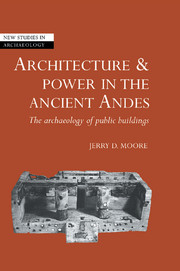Book contents
- Frontmatter
- Contents
- List of figures
- List of tables
- Acknowledgments
- 1 The contemplation of ruins: archaeological approaches to architecture
- 2 A sample of ancient Andean architecture: a critical description
- 3 The architecture of monuments
- 4 The architecture of ritual
- 5 The architecture of social control: theory, myth, and method
- 6 Summary and implications
- References
- Index
- NEW STUDIES IN ARCHAEOLOGY
6 - Summary and implications
Published online by Cambridge University Press: 26 October 2011
- Frontmatter
- Contents
- List of figures
- List of tables
- Acknowledgments
- 1 The contemplation of ruins: archaeological approaches to architecture
- 2 A sample of ancient Andean architecture: a critical description
- 3 The architecture of monuments
- 4 The architecture of ritual
- 5 The architecture of social control: theory, myth, and method
- 6 Summary and implications
- References
- Index
- NEW STUDIES IN ARCHAEOLOGY
Summary
… to this day in Peru many who see them
do not know what they are.
The Augustinians on ancient architecture“Space is never empty,” the geographer Edward Relph writes (1976: 10), “but has content and substance that derive both from human intention and imagination and from the character of the space.” Relph describes the different kinds of space humans experience and create: the unselfconscious space experienced by an infant moving without reflection, the space shaped by human perception, and space which is cognitive and abstract. Like other elements in the cultural landscape, architecture often contains explicit material statements about human intention and imagination, expressing human desires to literally shape the world. When such material patternings become widespread and shared, we are seeing the physical remains of what Relph calls “existential space”:
Existential or lived in space is the inner structure of space as it appears to us in our concrete experience of the world as members of a cultural group … It is intersubjective and hence amenable to all members of that group for they have all been socialized to a common set of experiences, signs, and symbols … existential space is not merely a passive space waiting to be experienced, but is constantly being created and remade by human activities. It is the space in which “human intention inscribes itself on the earth” (Dardel 1952: 40) and in doing so creates unselfconsciously patterns and structures of significance through the building of towns, villages, and houses, and the making of landscapes.
(Relph 1976: 12)- Type
- Chapter
- Information
- Architecture and Power in the Ancient AndesThe Archaeology of Public Buildings, pp. 220 - 228Publisher: Cambridge University PressPrint publication year: 1996

